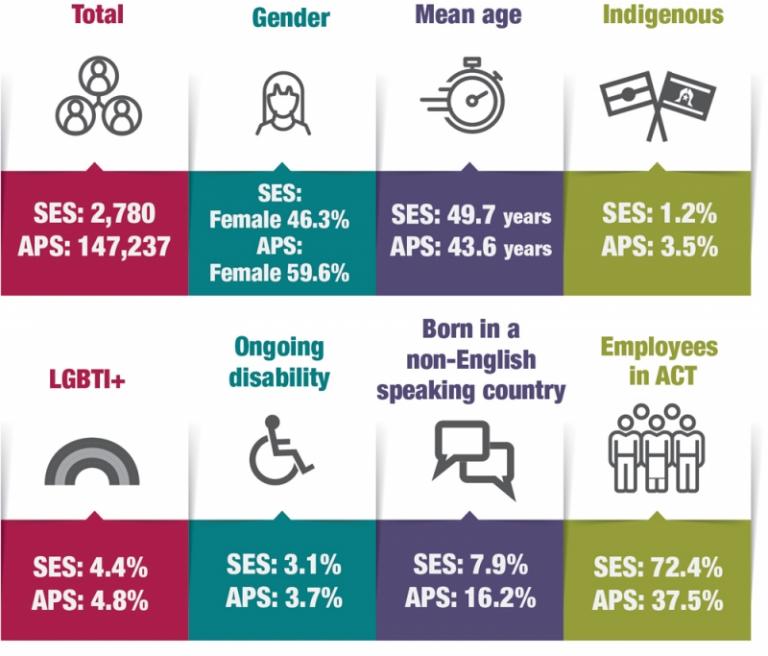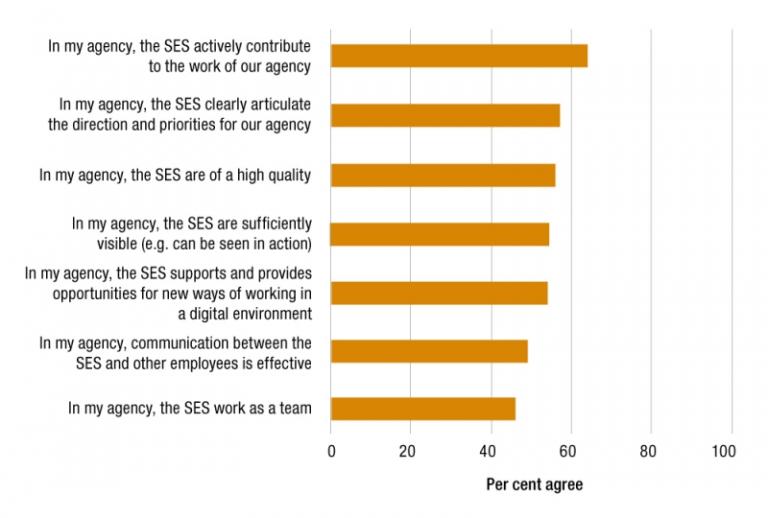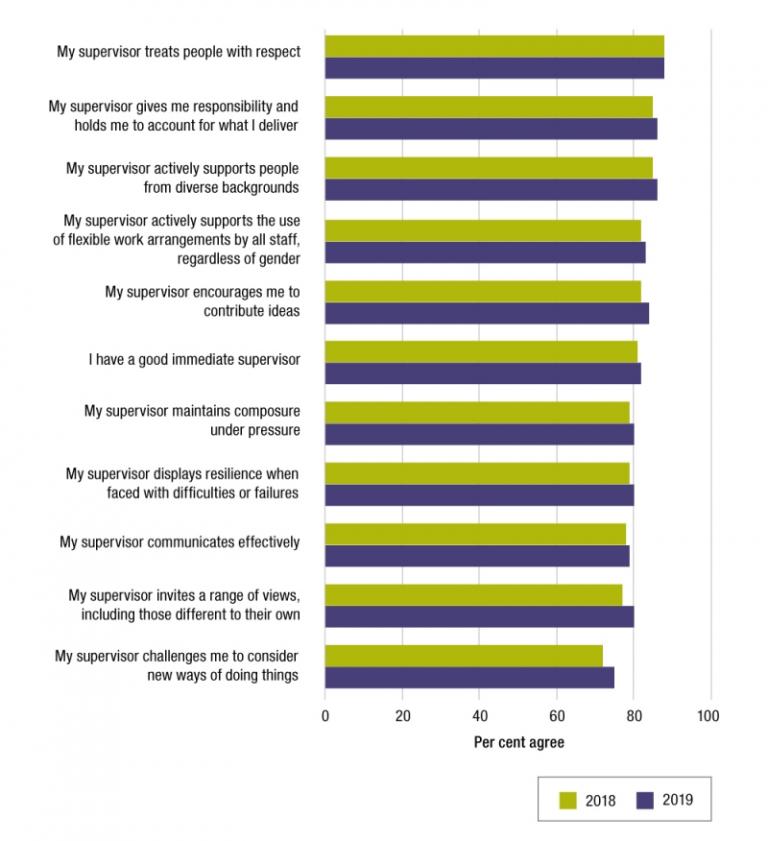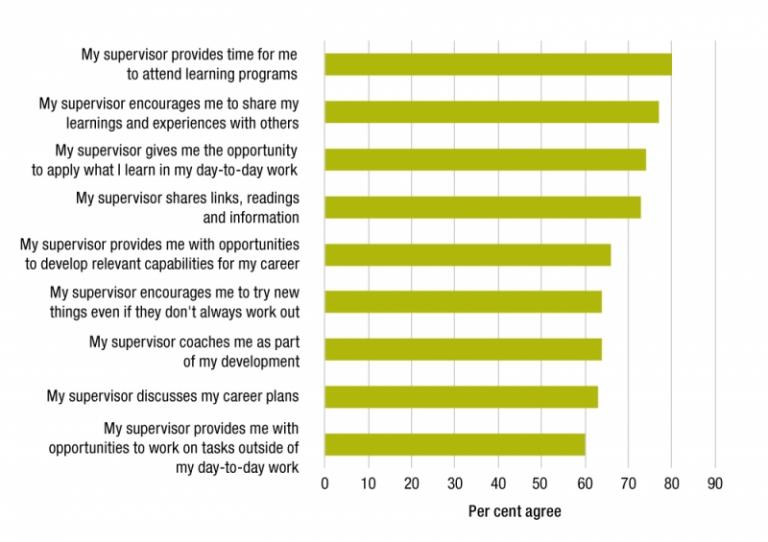Chapter 6: Building leaders
The future isn’t what it used to be … it is in these times of ambiguity and unpredictability that leadership becomes a key element of success for organisations.
- Nancy Chahwan, Chief Human Resources Office, Treasury Board of Canada Secretariat101
Public sector institutions across the world are grappling with the impact of technological and societal change on existing approaches to leadership. Long-established leadership capabilities, such as conceptual and analytical thinking and strategic planning, remain essential; however, there is growing recognition that ‘soft skills’—such as the ability to engage with multiple stakeholders, and effectively mobilise diverse teams—are core leadership capabilities for the future.
In the APS context, at the broadest level, leadership is about mobilising people to make progress on challenges that make a difference for the nation. This includes engaging others to bring about change, to innovate, collaborate and move toward a new vision of the future. It also includes challenging current thinking and ways of working, to deliver better outcomes for government and citizens.
Senior APS leaders are high-calibre individuals, with a strong commitment to public service as a vocation. They have been part of an institution that has traditionally valued and rewarded conceptual, analytical and technical capabilities, as these have been critical to finding solutions and getting things done. A cautious approach to risk and innovation has also been valued, contributing to institutional stability.
However, as described elsewhere in this report, recent years have seen foundational shifts in the operating environment of the APS. ‘Complex’, ‘ambiguous’, ‘uncertain’ and ‘disruptive’ are not just buzzwords – they accurately describe the reality of the policy, regulatory and service delivery challenges Australia is facing. These challenges require a broader repertoire of leadership responses at all levels, particularly for the SES.
In this environment, being adept at working across organisational and system boundaries is just as important as technical expertise in delivering outcomes. Similarly, being able to draw on diverse skills and perspectives, and having the courage to test new approaches, are as critical to solving complex problems as analytical skills.
The Senior Executive Service
The SES functions as the senior leadership cadre of the APS. The SES was introduced in 1984, and ‘was intended to produce a more unified and cohesive group of senior staff … and to provide a greater degree of management leadership’.102 The role of the SES has evolved since its introduction. Its current functions, as listed in the PS Act, are to:
- provide APS-wide strategic leadership of the highest quality that contributes to an effective and cohesive APS
- provide professional/specialist expertise, policy advice, program or service delivery, and regulatory administration at a high level
- promote cooperation within and between other agencies including to deliver outcomes across agency and portfolio boundaries
- promote, by personal example and other appropriate means, the APS Values, the APS Employment Principles and compliance with the Code of Conduct.
The SES also has a role in supporting secretaries as stewards of the broader APS.
Stewardship looks to build for the future, continually developing the right capability so the APS can always deliver the best outcomes for the Australian community.
As at 30 June 2019, there were 2,780 SES employees in the APS according to APSED data. Of these, 74 per cent were Band 1s, 21 per cent Band 2s and 5 per cent Band 3s. Ninety-six per cent of the SES were in ongoing roles. This suggests there is little appetite to use the flexibility provided through non-ongoing employees at the SES level. To compare, 10 per cent of non-SES staff are non-ongoing.
As highlighted in Figure 6.1, APSED and employee census data show that the SES remain the least diverse cohort in the APS. At the same time, SES are much more likely to have worked in multiple agencies than the rest of the APS workforce—63 per cent versus 28 per cent.
Figure 6.1: Snapshot of APS SES diversity

Note: SES (Bands 1, 2 and 3 grouped), APS as a whole (including SES)
Source: APSED and 2019 APS employee census
Leadership capabilities in the SES
In 2017, the Secretaries Board endorsed a set of leadership capabilities for SES roles that reflect what is needed from senior leaders. These capabilities underpin SES talent management, capability assessment and development. They reflect the expectation that, in serving government and citizens, senior APS leaders will provide vision and direction, be influential and collaborative, look for new ways of doing things that add public value, and build the capability of their teams and organisations.
Figure 6.2: Leadership capabilities for senior roles

Visionary
To provide the best policy advice to government, senior leaders need to be able to scan the horizon for emerging trends, identifying opportunities and challenges for the nation.
Influential
To take the government’s policy agenda forward, senior leaders need the capacity to persuade others towards an outcome, winning and maintaining the confidence of government and key stakeholders.
Collaborative
In making progress on issues that cut across agencies, sectors and nations, senior leaders need to be able to develop relationships, build trust and find common ground with others. An openness to diverse perspectives is critical.
Entrepreneurial
In finding new and better ways of achieving outcomes on behalf of government and citizens, senior leaders need to be able to challenge current perspectives, generate new ideas and experiment with different approaches. They also need to be adept at managing risk.
Enabling
Creating an environment that empowers individuals and teams to deliver their best for government and citizens is a core requirement for senior leaders. This includes setting expectations, nurturing talent and building capability.
Delivery
Senior leaders need to be highly skilled at managing the delivery of complex projects, programs and services. This includes harnessing the opportunity provided by digital technology to improve delivery outcomes for citizens.
Self-awareness, courage and resilience
These personal qualities sit at the heart of effective leadership in the APS. For APS leaders, mobilising and driving change requires a strong capacity for action and agency on the one hand, and an equally strong capacity for understanding and contending with constraints. Self-awareness, courage and resilience enable senior leaders to hold steady through the challenges of leadership.
The SES are well educated and experienced. According to APSED data, 91 per cent have tertiary qualifi ations, and the number of SES with post graduate qualifi ations has remained steady over the past decade. The APSC’s talent management assessments consistently show that SES participants in APS talent programs are highly intelligent and benchmark well against private sector executives. In particular, the assessments found that the ability of these leaders to navigate a much more complex set of objectives, issues and multi-stakeholder environments was a standout relative to the majority of the private sector.
SES officers are impressive leaders with potential to take on large and complex leadership roles. They have often excelled in demanding roles and are motivated by service to others. Across the six capabilities outlined in Figure 6.2, ‘delivery’ was consistently the strongest indicator in APSC talent assessments. The fact that 80 per cent of all SES roles filled in 2018–19 were promotions from within an agency (APSED data) could suggest that recruitment decisions focus on the requirements of the role and specific delivery experience rather than broader leadership experience.
The 2019 APS employee census results reinforce the focus on delivery and service to others. When SES were asked if they were happy to go the ‘extra mile’ at work when required, virtually all agreed (99 per cent). When asked about working beyond what is required in their job to help their agency achieve its objectives, responses were again strongly positive (96 per cent). Almost all SES reported being committed to their agency’s goals (96 per cent) and believed strongly in the purposes and objectives of their agency and the broader APS (96 per cent) (Figure 6.3).
Figure 6.3: SES and non-SES employee perceptions of commitment

Source: 2019 APS employee census
The focus on delivery is a key strength for the SES but there is evidence that other leadership capabilities important for the APS are less developed. Analysis of SES experiences reported in the APSC’s talent assessment processes shows that the two lowest measured capabilities for SES are ‘enabling’ and ‘entrepreneurial’—the two capabilities key to delivering innovative outcomes through teams.
The APS employee census results reinforce the view that enabling and risk management are not areas of strength for the SES. The statement that ‘my SES gives their time to identify and develop talented people’ was not rated highly, with 47 per cent of respondents agreeing. Only 60 per cent of respondents perceived their SES manager could effectively lead and manage change. Sixty-two per cent of employees reported their SES manager encouraged innovation and creativity.
Only 43 per cent of APS employee census respondents agreed that senior leaders in their agency demonstrated the importance of managing risk appropriately. This contrasts starkly with the perceptions of the SES cohort on the same question (74 per cent positive).
Nevertheless, SES managers are well regarded across the APS. Figure 6.4 presents a number of questions relating to APS employee perceptions of their SES managers, as recorded in the 2019 APS employee census. Although lower across the board than employees’ perceptions of their immediate supervisors (see next section in this chapter), the findings are broadly positive in absolute terms.
Figure 6.4: APS employee perceptions of their immediate SES manager

Source: 2019 APS employee census
The APS employee census also captured employee perceptions of the SES as a cohort within their home agency (Figure 6.5). Respondent perceptions of their agency-specific SES cohort were lower than perceptions of their immediate SES. The highest rated perceptions of the SES group included contributing to the work of their agency, and clearly articulating the direction and priorities for the agency. These align with the ‘delivery’ and ‘visionary’ capabilities.
Just under half of 2019 APS employee census respondents agreed their SES work as a team. Coupled with lower perceptions of communication between SES and other employees, this suggests that the ‘collaborative’ leadership capability (outlined in Figure 6.2) requires continued focus and further analysis to understand if the system currently incentivises collaborative behaviours.
Figure 6.5: APS employee perceptions of SES within their agency

Source: 2019 APS employee census
Immediate supervisors
While the SES have a key part to play as the senior leadership cadre of the APS, the role of immediate supervisors in managing and leading the APS is also critical. Every year the APS employee census measures employee views about the quality and capability of immediate supervisors, which largely comprise APS 5 to EL 2 staff.
Consistent with results from previous years, employee perceptions about their immediate supervisors were very positive, with increases in 2019 across almost all questions (Figure 6.6). A high proportion of respondents agreed their immediate supervisor treats people with respect, supports people from diverse backgrounds and holds employees to account for what they deliver.
Figure 6.6: APS employee perceptions of their immediate supervisors, 2018 to 2019

Source: APS employee census
Supervisors also play an important part in developing employee capability and APS employee census respondents indicated that supervisors provide time for their employees to attend learning programs (80 per cent positive response) and share learnings with others (77 per cent), as well as giving employees opportunities to apply learnings (74 per cent) (Figure 6.7).
It is widely recognised that formal learning programs, while important, only make up a relatively small part of an employee’s total time investment in learning and development activities. Activities that occur as part of an employee’s regular work—such as coaching, constructive feedback, acting opportunities, and peer-to-peer learning—are just as important in developing employee capability. Supervisors play a key role in these sorts of learning opportunities, particularly through targeted and constructive coaching and feedback to their employees. However, the 2019 APS employee census results indicate that employee perceptions of these aspects of the supervisor-employee relationship, along with career discussions and career planning, were relatively less positive (Figure 6.7).
Figure 6.7: APS employee perceptions of their immediate supervisor’s approach to developing capability

Source: APS employee census
The benefit of coaching and career discussions extends beyond employee capability development. Employees who rated their supervisors more highly on these measures also had higher scores on the engagement index. There is no doubt that coaching and career conversations require an additional time investment, but the relationship with engagement suggests that the return on the time invested is potentially substantial.
The 2019 amendments to the Commissioner’s Directions specifically address this issue by requiring all employees with supervisory responsibilities to conduct career conversations with their staff annually at a minimum. (See Chapter 1 for further discussion on the Commissioner’s Directions.)
Developing existing leaders
There are many stakeholders involved in supporting development of leadership capabilities across the APS. These include individual agency learning and development units, external education providers (including universities and ANZSOG) and APS specialist development hubs.
The APSC also plays an important role in supporting the APS with strategic guidance and services in learning and development, leadership development and talent management. The APSC performs this work on behalf of the Secretaries Board, with the support of a cross-sector Advisory Board.
The APSC currently offers formal leadership development programs for SES and EL 2 employees. These programs support participants to build networks of peers across agencies and learn together. They aim to build critical leadership capabilities in areas such as:
- reading and navigating the political context
- influencing through complexity and ambiguity
- harnessing difference and working with complex stakeholder networks
- building high performing work cultures
- leading change
- building self-awareness and resilience.
Participant and manager evaluations of these programs indicate that individuals take significant value from their experiences across leadership development programs. Formal evaluation of participant confidence to apply particular skills has consistently shown increases in individual capacity, both immediately after workshops and six months later.
SES Band 2 community immersive—Australian Public Service Commission
The SES Band 2 Leadership program offered by the APSC assists SES leaders to better understand the interaction between citizens and government.
In 2019, SES Band 2 Leadership program participants were immersed in the Nowra local community. They engaged with community leaders, organisations and citizens, listening to their experiences of interactions with government as well as the challenges and opportunities they had faced.
Viewing government interaction through the eyes of those who deliver and receive government services on a daily basis prompted program participants to reflect on how the APS could be more innovative, citizen-centric and effective when designing and delivering services for the Australian people.
The community experience highlighted to participants:
- the value of discussions on the ground with communities
- the importance of deep listening and understanding, not simply rushing to solve complex issues
- the need to take into account multiple perspectives on complex issues
- the impact of building trust when working with communities
- the need to get out, consult more and keep programs and policies simple and effective, always conscious of the impact on the ground.
Before leaving Nowra, the program participants shared what they had learnt with the community and personally committed to future action. As a group, they promised the Nowra community to ‘work hard in our roles to serve your community and all the other communities you represent’.
Identifying and growing future leaders
Talent management in the APS is the systematic identification, development and deployment of individuals with potential for more challenging roles in the future (Figure 6.8). It is a key business strategy and an investment in the future capability of the APS. Taking a systematic approach to managing the growth of high-potential employees ensures the APS has the right people ready for critical roles now and in the future.
The Secretaries Board endorsed an APS-wide approach to talent management in December 2017. As part of this approach, talent processes for the SES cohort are managed at a cross-APS level, with active support from agencies. Cross-APS talent management is led by the Secretaries Talent Council and Deputy Secretaries Talent Council on behalf of the Secretaries Board. Below SES level, talent is managed by agencies, drawing on common APS guidance and tools provided by the APSC.
The key principles underpinning talent management in the APS are:
- Talent management is owned and led by APS leaders, who are actively engaged in the process with a view to the longer-term interests of their agency and the wider APS. Senior leaders, as stewards of the APS, play a particular leadership role in driving effective talent management in their agency and across the APS.
- The identification of talent is based on valid and objective assessment, ensuring officers are receiving the right development and focus at specific times in their career.
- Talent management is systematic and dynamic and the process:
- involves regularly and actively identifying, planning and monitoring high-potential individuals: who they are; how they are being developed; the career ‘next steps’ that will best help them realise their potential
- recognises that an assessment of potential may change depending on an individual’s circumstances or career stage. As such, potential is regularly monitored and reassessed.
- Talent management recognises the importance of a diverse leadership cadre and actively seeks to develop one.
Figure 6.8: Talent management system

Talent management of the SES cohort is overseen by two talent councils—the Secretaries Talent Council and the Deputy Secretaries Talent Council. The initial focus of the Secretaries Talent Council was on high-performing SES Band 3s with the potential to move into secretary or agency head roles, or more complex Band 3 roles. In June 2019, the Secretaries Board agreed to broaden the Band 3 talent assessment process to include all Band 3s. This will assist the Board with its leadership and stewardship responsibilities at whole-of-APS level.
The Deputy Secretaries Talent Council focuses on SES Band 1s and Band 2s with high potential for SES Band 3 roles. Those assessed as having potential for careers that span across the APS to Band 3 in the future, and who would benefit from a cross-APS focus to their development at this point in their career, may become members of the Deputy Secretaries Talent Pool. These individuals receive guidance and input from the Council on their career development.
In addition to the benefit to individuals participating in formal programs, work undertaken by the two talent councils has assisted secretaries and deputy secretaries to gain a deeper understanding of the capability and potential of the broader SES cohort.
In previous years the APSC offered a Career Development Assessment Centre as a common tool to assist agencies to assess EL 2 readiness for entry into the SES. The conclusion of the contract for the assessment centre process during 2018 created an opportunity for a revised approach to talent management for the EL 2 cohort.
In early 2019, a new program was developed, using the SES Band 1 Work Level Standards to assess participants’ future potential for SES Band 1 roles. A pilot of the revised program began in May 2019, with 12 participants from four APS agencies. Feedback from pilot participants has been positive. An evaluation report and post implementation review will consider suitability of the process and inform decisions on broader use across the APS.
Leadership challenges
Responding to challenging policy and delivery requirements in a rapidly changing and increasingly digital environment requires leaders who are transformational and expert change managers. They need to be adaptive and collaborative. Complexity and increased expectations mean leaders need to find new and better ways of doing things, question current perspectives and generate new ideas. They need to manage risk deftly and enable their staff and networks to deliver for the end user.
The APS is not alone in the challenge of recruiting, developing and managing talent that can respond to changing leadership pressures. Both private and public sector organisations are considering the capability needed to lead organisations into the future.
The data currently available is not comprehensive, but shows apparent gaps in SES capability in enabling staff, managing change, being innovative and having diversity of perspective. In addition, demographic data suggests the organisation and deployment of the APS leadership cohort may not be as effective as it could be in supporting the workforce that they lead.
These issues need to be examined further to ensure the SES and other leaders can assist the APS in responding to future challenges. Talent and mobility initiatives currently under way will also play a part in ensuring there is a pipeline of APS employees with the required leadership capabilities. The integrity of the public service, and citizen and government trust in its ability to provide high quality and responsive advice, depend on a capable, dynamic, collaborative, innovative and supported leadership cohort.



